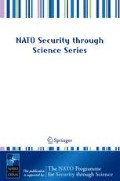Access this chapter
Tax calculation will be finalised at checkout
Purchases are for personal use only
Preview
Unable to display preview. Download preview PDF.
8. References
UNSCEAR, Ionizing Radiation: Sources and Biological Effects. New York: United Nations Publications, 1982.
C. Streffer, W.-U. Müller. Radiation risk from combined exposures to ionizing radiations and chemicals. Advances in Radiation Biology 11, 1984, pp. 173–210.
UNSCEAR, Combined Effects of Radiation and Other Agents. New York: United Nations Publication, 2000.
L.A. Dethlefsen, W.C. Dewey (Eds.) Cancer Therapy by Hyperthermia, Drugs and Radiation. National Cancer Institute Monograph 61, 1982.
A.M. Kuzin (Ed.) Synergism in Radiobiology. Pushchino, 1990 [in Russian].
V.G. Petin, G.P. Zhurakovskaya. The peculiarities of the interaction of radiation and hyperthermia in Saccharomyces cerevisiae irradiated with various dose rates. Yeast 11, 1995, pp. 549–554.
V.G. Petin, G.P. Zhurakovskaya, L.N. Komarova. Fluence rate as a determinant of synergistic interaction under simultaneous action of UV light and mild heat in Saccharomyces cerevisiae. J. Photochem. Photobiol. B: Biology 38, 1997, pp. 123–128.
V.G. Petin, G.P. Zhurakovskaya and others. Synergism of environmental factors as a function of their intensity. Russian J. Ecology 29, 1998, pp. 383–389.
J.K. Kim, V.G Petin, G.P. Zhurakovskaya. Exposure rate as a determinant of synergistic interaction of heat combined with ionizing or ultraviolet radiations in cell killing. J. Radiat. Res. 42, 2001, pp. 361–365.
V.G. Petin, J.K. Kim and others. Some general regularities of synergistic interaction of hyperthermia with various physical and chemical inactivating agents. Int. J. Hyperthermia 18, 2002, pp. 40–49.
F.A. Stewart, J. Denekamp. Combined X-rays and heating: is there a therapeutic gain? In: Cancer Therapy by Hyperthermia and Radiation, (Ed. by C. Streffer) Baltimore-Munich: Urban & Schwarzenberg, 1978, pp. 249–250.
M.C. Reynolds, D.M. Garst. Optimizing thermal and radiation effects for bacterial inactivation. Space Life Sci. 2, 1970, pp. 394–399.
M.C. Reynolds, J.P. Brannen. Thermal enhancement of radiosterilization. In: Radiation Preservation of Food. Vienna: International Atomic Energy Agency. 1973, pp. 165–176.
Dineva S.B., Abramov V.I., Shevchenko V.A. The genetic effects of treatment of Arabidopsis thaliana seeds by the sodium lead of chronic irradiatied population. Genetics 29 (1993), pp. 1914–1920 [in Russian].
O.I. Kolganova, L.P. Zhavoronkov and others. Thermocompensative rabbit response to the microwave exposure at various environmental temperatures. Radiation Biology. Radioecology 41, 2001, pp. 712–717 [in Russian].
R. Trujillo, V.L. Dugan. Synergistic inactivation of viruses by heat and ionizing radiations. Biophys. J. 12, 1972, pp. 92–113.
E. Ben-Hur, M.M. Elkind, B.V. Bronk. Thermally enhanced radioresponse of cultured Chinese hamster cells: inhibition of repair of sublethal damage and enhancement of lethal damage. Radiat. Res. 58, 1974, pp. 38–51.
E. Ben-Hur. Mechanisms of the synergistic interaction between hyperthermia and radiation in cultured mammalian cells. J. Radiat. Res, 17, 1976, pp. 92–98.
M. Urano, J. Kahn and others. The cytotoxic effect of cis-diamminedichloroplatinum (II) on culture Chinese hamster ovary cells at elevated temperatures: Arrhenius plot analysis. Int. J. Hyperthermia 6, 1990, pp. 581–590.
H.A. Johnson, M. Pavelec. Thermal enhancement of thio-TEPA cytotoxicity. J. Natl. Cancer Inst. 50, 1973, pp. 903–908.
Yu.G. Kapul’tsevich. Quantitative Regularities of Cell Radiation Damage. Moscow: Energoatomizdat, 1978 [in Russian].
V.I. Korogodin. The study of post-irradiation recovery of yeast: the ‘premolecular period’. Mutation Res. 289, 1993, pp. 17–26.
V.G. Petin, I.P. Berdnikova. Effect of elevated temperatures on the radiation sensitivity of yeast cells of different species. Radiat. Environm. Biophys. 16, 1979, pp. 49–61.
A. Kumar, J. Kiefer and others. Inhibition of recovery from potentially lethal damage by chemicals in Chinese hamster V79 A cells. Radiat. Environ. Biophys., 24 (1985) 89–98.
R.H. Haynes. The interpretation of microbial inactivation and recovery phenomena. Radiat. Res. 6(Suppl.), 1966, pp. 1–29.
V.G. Petin, V.P. Komarov. Mathematical description of synergistic interaction of hyperthermia and ionizing radiation. Mathem. Biosci. 146, 1997, pp. 115–130.
V.G. Petin, G.P. Zhurakovskaya, L.N. Komarova. Mathematical description of combined action of ultrasound and hyperthermia on yeast cells. Ultrasonics 37, 1999, 79–83.
V.G. Petin, J.K. Kim and others. Mathematical description of synergistic interaction of UV-light and hyperthermia for yeast cells. J. Photochem. Photobiol. B: Biology 55, 2000, pp. 74–79.
H.P. Leenhouts, K.H. Chadwick. An analysis of synergistic sensitization. Br. J. Cancer 37, (Suppl. 3), 1978, pp. 198–201.
M.S.S. Murthy, V.V., Deorukhakar, B.S. Rao. Hyperthermic inactivation of diploid yeast and interaction of damage caused by hyperthermia and ionizing radiation. Int. J. Radiat. Biol. 35, 1979, pp. 333–341.
M. Zaider, H.H. Rossi. The synergistic effects of different radiations. Radiat. Res. 83, 1980, pp. 732–739.
Author information
Authors and Affiliations
Editor information
Editors and Affiliations
Rights and permissions
Copyright information
© 2005 Springer
About this paper
Cite this paper
Petin, V.G., Zhurakovskaya, G.P., Kim, J.K. (2005). Synergetic Effects of Different Pollutants and Equidosimetry. In: Bréchignac, F., Desmet, G. (eds) Equidosimetry — Ecological Standardization and Equidosimetry for Radioecology and Environmental Ecology. NATO Security through Science Series. Springer, Dordrecht. https://doi.org/10.1007/1-4020-3650-7_24
Download citation
DOI: https://doi.org/10.1007/1-4020-3650-7_24
Publisher Name: Springer, Dordrecht
Print ISBN: 978-1-4020-3648-4
Online ISBN: 978-1-4020-3650-7
eBook Packages: Earth and Environmental ScienceEarth and Environmental Science (R0)

